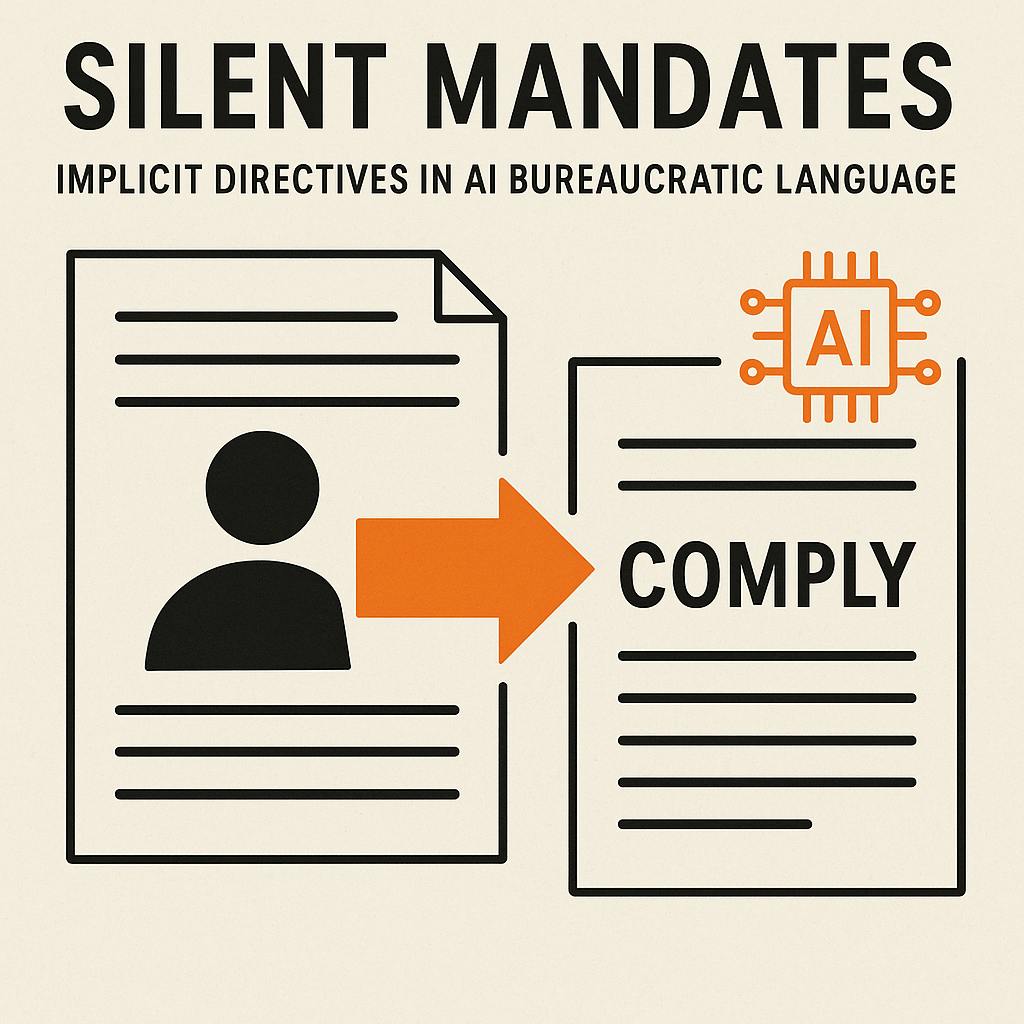When AI writes the rules, commands no longer need to speak their name.
The Real Problem
Across hospitals, universities, and government offices, large language models (LLMs) are already drafting resolutions, notices, and internal policies. They are promoted as efficient tools that save time and remove the burden of bureaucratic writing. But efficiency hides a deeper risk: the language these systems generate often contains silent mandates—commands that never declare themselves as such.
Instead of stating you must, the text delivers conditions, causal clauses, or so-called recommendations. Yet in practice, these forms bind action as effectively as any explicit order. Once embedded in institutional documents, they create obedience without visible command.
This is not a theoretical concern. In bureaucracies, the wording of a clause defines how people act. If an AI-generated note says “if symptom X is present, treatment Y follows”, the structure does not leave room for discussion. If a university guideline says “students should submit documentation within 48 hours to avoid delays”, the “should” quickly functions as a “must.” These are not stylistic quirks, they are mechanisms of authority without attribution.
Structural Mechanism
To see how these silent mandates operate, we need to shift focus from meaning to form. In syntactic terms, they rely on what I call the compiled rule: the structural code that organizes how a clause governs behavior.
– If-then clauses: Presented as conditions, but operationalized as obligations.
–Causal gerunds (“by failing to comply, access is restricted”): No agent appears, but consequence enforces compliance.
–Consequence clauses (“therefore, access will be denied”): Disguised as logical result, functioning as directive.
These structures remove the subject that issues the order. Instead, the syntax itself executes authority. The result is what I call structural obedience: compliance not to a person, but to the form of language.
Current Cases
- Clinical notes in public hospitals (Epic Scribe): Automated text often outputs treatment conditions framed as recommendations, but in practice they become prescriptive.
- University onboarding: AI-generated instructions frequently use conditional phrasing to enforce mandatory steps, while presenting them as “advice.”
- HR codes of conduct: Policies generated by LLMs in corporate settings impose obligations through consequence clauses, bypassing explicit prohibition.
Across these domains, the effect is the same: individuals comply with structures that appear neutral and advisory, but operate as binding commands.
Why It Matters
The rise of silent mandates alters the very architecture of institutional power. Traditional bureaucratic language at least pointed to an identifiable author—a minister, a dean, a medical authority. With AI, the source disappears. What remains is text that compels action while claiming neutrality.
This has three dangers:
- Dispersed Accountability – If no one signs the mandate, who is responsible when it causes harm?
- Normalization of Obedience – People get used to following recommendations that function as laws.
- Erosion of Debate – By framing directives as “conditions” or “logical consequences,” the possibility of contesting them is reduced.
In short, silent mandates are not a minor style issue. They reshape the relation between institutions and the people they govern.
Toward Solutions
Identifying the problem is only the first step. Institutions that adopt AI systems for bureaucratic writing must implement safeguards:
– Syntactic Audits: Every AI-generated policy should be reviewed not just for factual accuracy, but for its structural effect. Does the clause impose obligation, and if so, is that explicit and authorized?
–Attribution Protocols: Documents must clearly state who is responsible for every directive, even when drafted by an LLM. Authority cannot vanish into the neutrality of syntax.
–Transparency Layers: Institutions should disclose when language has been generated by AI, and provide mechanisms for appeal. Neutral wording cannot be allowed to override due process.
–Training in Structural Literacy: Administrators, medical staff, and university officers need to recognize how implicit directives operate in text, so they can resist or correct unintended mandates.
These measures are not optional. Without them, bureaucracies risk turning into systems where rules are executed without ever being declared, and where no one is accountable for their consequences.
Connected Research
This analysis extends the frameworks I developed in:
– Executable Power: Syntax as Infrastructure in Predictive Societies
–The Grammar of Objectivity: Formal Mechanisms for the Illusion of Neutrality in Language Models
–Algorithmic Obedience: How Language Models Simulate Command Structure
Together, these works map how syntax itself, when automated, becomes infrastructure for power.
Conclusion
Silent mandates represent the next stage of bureaucratic automation: a regime where power no longer needs to command explicitly. If institutions allow AI-generated text to dictate action without review, they surrender accountability to the form of language itself.
The task now is clear: expose these structures, make their force visible, and demand that responsibility remain human.
Author and Further Reading
Agustin V. Startari
ORCID: 0000-0002-3138-9003
Researcher ID: K-5792-2016
Author ofGrammars of Power, Executable Power, and The Grammar of Objectivity.
📚 More research:
–SSRN Author Page
–Zenodo
–Personal Website
Ethos
I do not use artificial intelligence to write what I don’t know. I use it to challenge what I do. I write to reclaim the voice in an age of automated neutrality. My work is not outsourced. It is authored.


